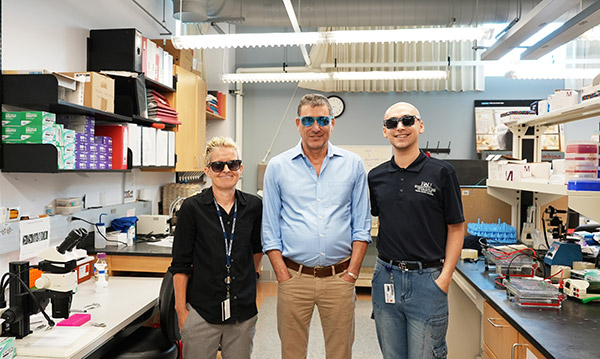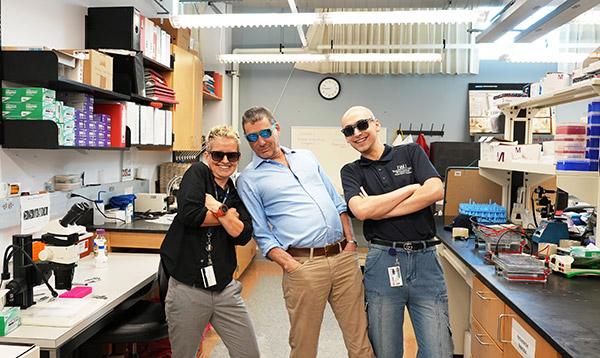Protecting Your Eyes This Summer: Insights and Tips from the Schmidt College of Medicine

As the summer sun blazes down on Florida, it’s crucial to understand the risks of UV light exposure to our eyes and how to protect our vision. Florida experiences some of the highest UV radiation levels in the United States, with UV indices often reaching extreme levels during summer months. According to the Environmental Protection Agency, the UV index in Florida during peak summer can exceed 11, indicating very high risk of harm from unprotected sun exposure.
Activities such as boating and other water sports significantly increase UV exposure due to the reflective nature of water. Studies show that UV radiation exposure can be up to 100% higher on water than on land. This makes it essential for Floridians and visitors alike to take extra precautions to protect their eyes.
Types of UV Protection for Your Eyes
To safeguard your vision, consider these types of UV protection:
- Sunglasses: Opt for sunglasses that block 100% of both UVA and UVB rays. Wraparound styles offer added protection by preventing UV rays from entering from the sides.
- Contact Lenses: Some contact lenses offer UV protection, but they should be used in conjunction with sunglasses for comprehensive coverage.
- Hats: A wide-brimmed hat can reduce the amount of UV rays reaching your eyes by up to 50%.

Understanding Cataracts and Retinal Degeneration
Cataracts and retinal degeneration are leading causes of vision impairment in the United States. The Blue Mountains Eye Study and the Chesapeake Bay Eye Study indicate that age-related macular degeneration affects about 11 million people in the U.S., with cataracts being a leading cause of blindness globally.
A cataract is a clouding of the eye’s lens, which leads to decreased vision. It typically progresses slowly, leading to vision problems such as blurriness, faded colors, and difficulty with night vision. UV exposure is a significant risk factor for cataract development.
Preventative measures include wearing UV-blocking sunglasses, avoiding direct sunlight during peak hours (10 AM to 4 PM), and regular eye check-ups. Symptoms of cataracts include blurry vision, seeing halos around lights, and double vision. If you experience any of these symptoms, consult your healthcare provider promptly.
Spotlight on Research at the Schmidt College of Medicine, Florida Atlantic University
Under the leadership of Dr. Marc Kantorow , the Schmidt College of Medicine is pioneering research into age-related eye diseases. Dr. Kantorow’s lab focuses on understanding the molecular and genetic mechanisms controlling eye cell differentiation, eye development, and ocular disease resistance, particularly in the eye lens. One significant discovery from his lab is the critical role of low oxygen levels, or hypoxia, in the formation of the lens and other eye structures. Their research has shown that cataract and ocular disease progression is accompanied by significant changes in the levels of key genes required for defense against environmental insults, including UV light.
By uncovering the mechanisms that control the expression of these genes, Dr. Kantorow's team is working towards developing gene therapy-based treatments to prevent and treat cataracts and other age-related ocular diseases. Their groundbreaking work also lays the foundation for engineering ocular tissues that could potentially replace damaged ones, offering hope for future regenerative therapies.
Q&A with Dr. Marc Kantorow, Associate Dean for Graduate Programs, Director Medical Post-Baccalaureate Certificate, and Professor of Biomedical Science:
- Q1: What inspired your interest in the study of cataracts and age-related eye diseases?
- A: I was interested in gene regulation, and one of the best models for understanding gene regulation is the eye lens. Since many of the genes are only expressed in the lens and since the lens is a relatively simple tissue composed of only two cell types, it allows you to study development and gene expression in one of the best model systems available.
- Q2: Can you explain the role of UV light in the development of cataracts and macular degeneration?
- A: UV light has damaging effects on the body, primarily causing DNA mutations. These mutations lead to aberrant gene expression, disrupting cell cycle control and causing various diseases. UV light also generates reactive oxygen species that result in oxidative stress, a major feature of cataract and retinal degeneration.
- Q3: What are the latest findings from your research on the genetic factors contributing to cataract formation and retinal degeneration?
- A: Our research focuses on the genetic programs that contribute to the development of the lens and retina. These programs include transcription factors, RNA regulation, and epigenetic mechanisms influenced by UV light. By identifying these pathways, we can understand how dysregulation causes ocular disease and develop new therapies to treat these conditions.
- Q4: How do you foresee the future of eye disease prevention and treatment evolving with current research?
- A: By identifying key pathways, we can develop ways to engineer tissues for replacement therapy. Prevention is crucial, but once damage occurs, it's irreversible. Our research aims to use engineered tissues to replace damaged ones, restoring visual function.
- Q5: What practical steps can individuals take to protect their eyes from UV damage based on your research?
- A: Avoid the sun during peak hours, wear UV-protective clothing, and use wraparound sunglasses to protect your eyes from UV rays, which are often reflected off surfaces like water.
Q&A with Dr. Lisa A. Brennan, Research Professor and Director, Graduate Programs Curriculum & Student Access:
- Q1: How is your lab’s research contributing to understanding how to prevent eye diseases?
- A: Our research focuses on understanding how the eye develops and maintains its structure and function. By studying gene expression and mutations that cause cataracts, we can uncover underlying mechanisms and develop potential therapies.
- Q2: What studies have you performed to directly determine how UV light affects the eye lens?
- A: In our 2016 study, we demonstrated that eye lens cells can consume dead cells, a process essential for lens maintenance. UV light exposure causes DNA damage, which leads to cell death. This discovery revealed how the lens manages cell death induced by UV light, providing valuable insights into potential therapeutic applications.
- Q3: Can you share any insights on how lifestyle choices might mitigate oxidative stress and support eye health?
- A: A healthy diet, exercise, not smoking, and moderating alcohol intake are crucial. Diets rich in antioxidants, like resveratrol and blueberries, can protect against oxidative stress and support eye health.
Practical Tips for Eye Health During Summer
- Wear UV-blocking sunglasses: Ensure your sunglasses offer 100% UVA and UVB protection.
- Use hats for additional shade: Wide-brimmed hats can provide extra protection against UV rays.
- Be mindful of reflective surfaces: Water, sand, and even pavement can reflect UV rays and increase exposure.
- Regular eye exams: Schedule annual check-ups with your eye care provider to monitor and maintain eye health.

By taking these steps, you can protect your eyes from harmful UV rays, maintain healthy vision, and enjoy the sunny Florida summer safely. The research being conducted at the Schmidt College of Medicine under the guidance of experts like Dr. Kantorow and Dr. Brennan is paving the way for better understanding and prevention of age-related eye diseases. Stay informed, stay protected, and enjoy a safe, sun-filled summer!